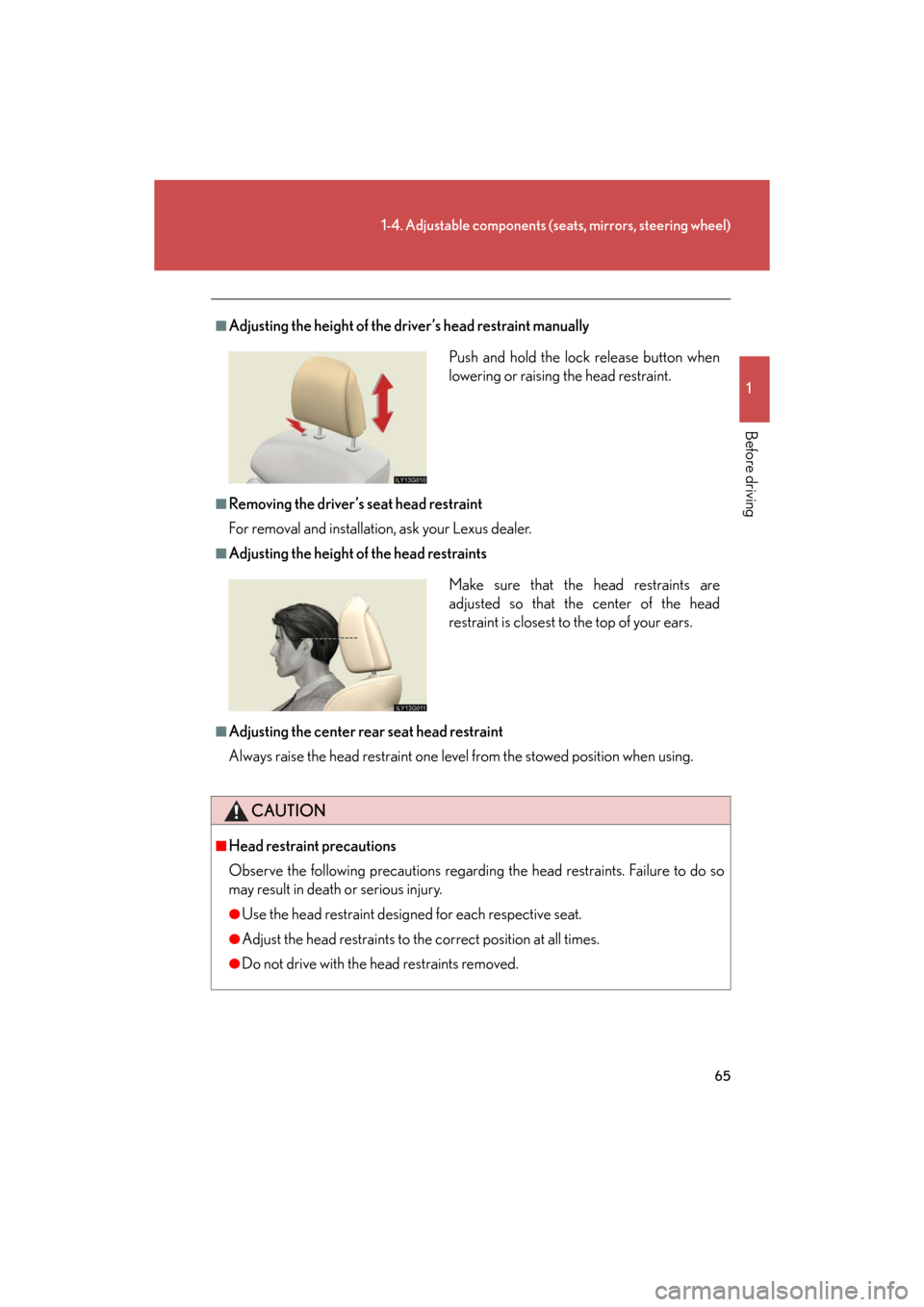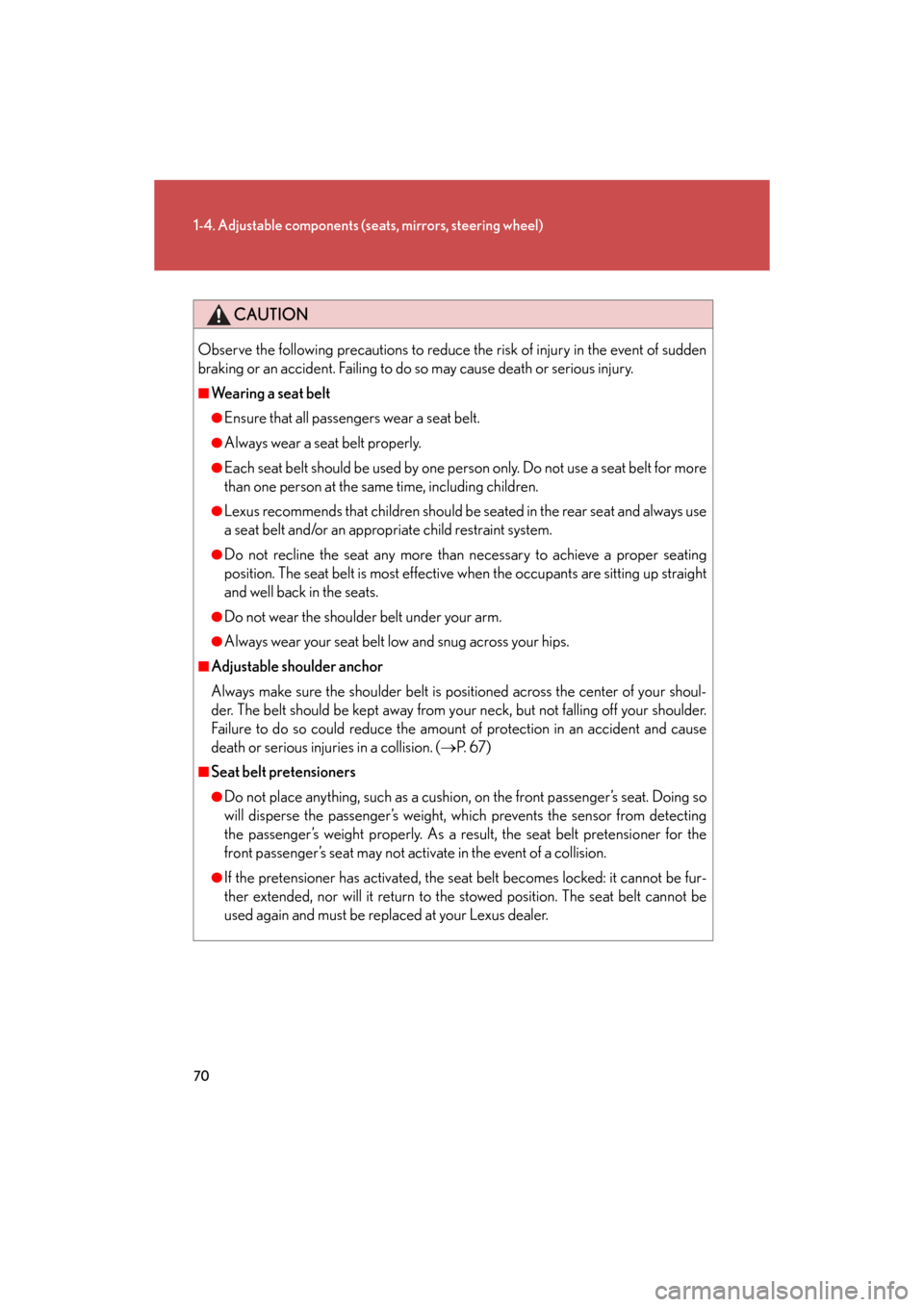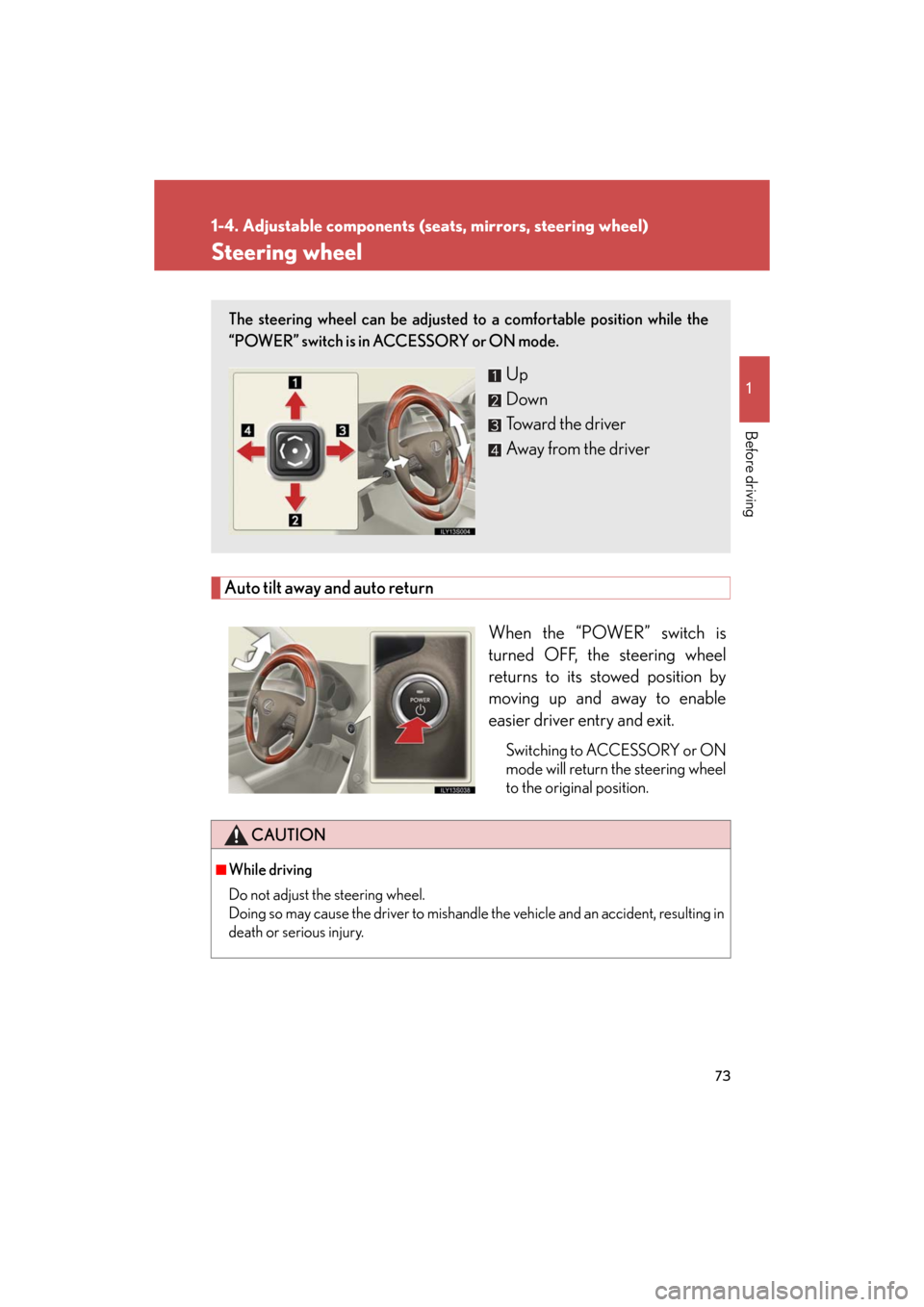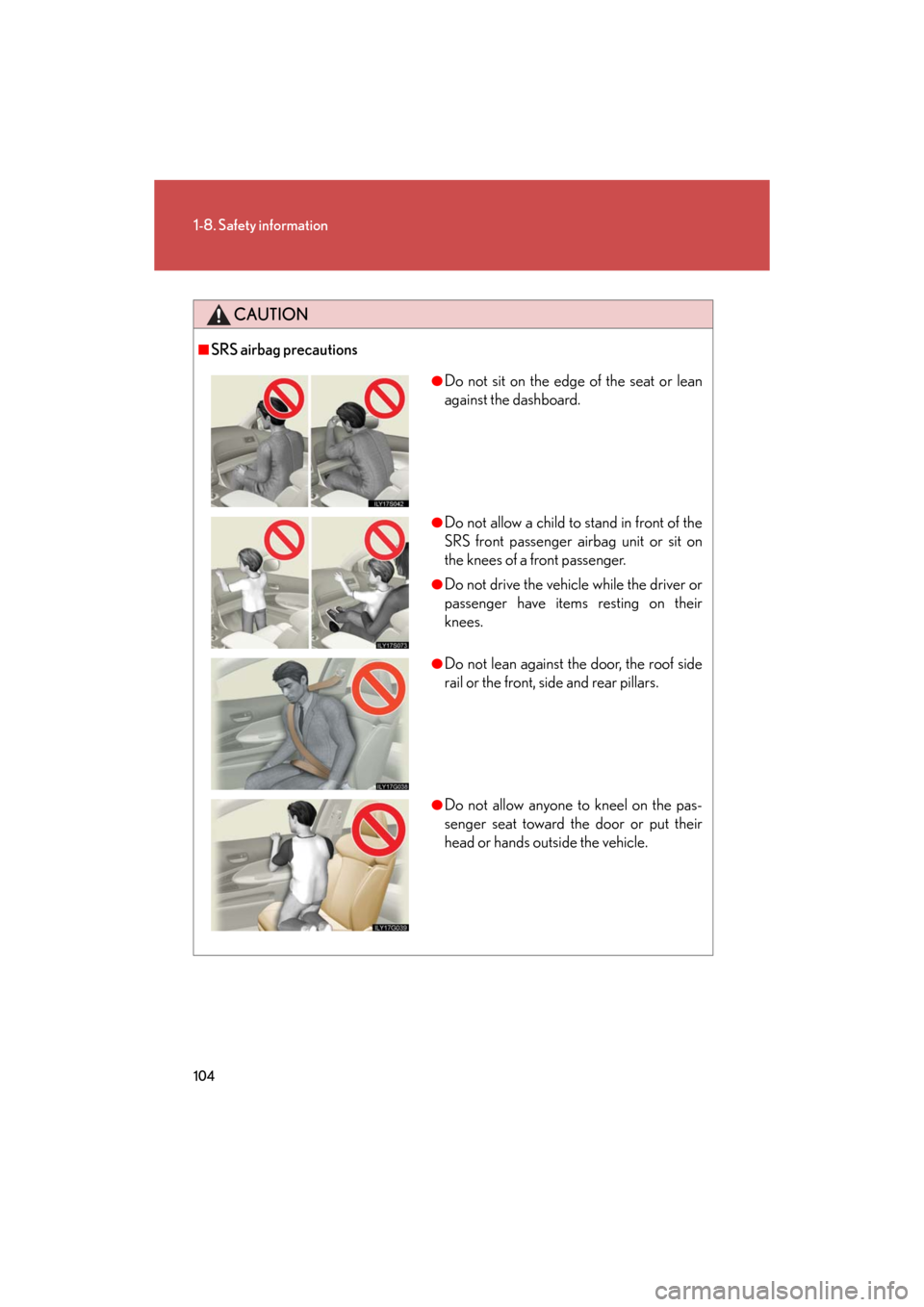tow Lexus GS450h 2008 Using the audio system / LEXUS 2008 GS450H OWNER'S MANUAL (OM30A96U)
[x] Cancel search | Manufacturer: LEXUS, Model Year: 2008, Model line: GS450h, Model: Lexus GS450h 2008Pages: 596, PDF Size: 9.36 MB
Page 1 of 596

TABLE OF CONTENTS
1
GS_HV_U
December 12, 2007 3:30 pm
1Before drivingAdjusting and operating features such as door locks, mir-
rors, and steering column
2When drivingDriving, stopping and safe-driving information
3Interior featuresAir conditioning and audio systems, as well as other interior
features for a comfortable driving experience
4Maintenance
and careCleaning and protecting your vehicle, performing do-it-your-
self maintenance, and maintenance information
5When trouble
arisesWhat to do if the vehicle needs to be towed, gets a flat tire,
or is involved in an accident
6Vehicle
specificationsDetailed vehicle information
7For ownersReporting safety defects for US owners and seat belt in-
structions for Canadian owners
IndexAlphabetical listing of inform ation contained in this manual
Page 3 of 596

1
2
3
4
5
6
7
3
GS_HV_U
December 12, 2007 3:33 pm
2-2. Instrument cluster..................... 148Gauges and meters ..................... 148
Indicators and warning
lights................................................. 152
Multi-information display........... 155
2-3. Operating the lights and
windshield wipers ................... 158
Headlight switch ............................ 158
Fog light switch ................................ 161
Windshield wipers and
washer............................................. 162
Headlight cleaner switch ........... 165
2-4. Using other driving
systems ....................................... 166
Cruise control ................................ 166
Dynamic radar cruise
control............................................. 169
Intuitive parking assist ................. 180
Rear view monitor system ......... 195
AVS (Adaptive Variable
Suspension System) .................. 199
Driving assist systems................ 200
PCS (Pre-Collision
System) .......................................... 206
2-5. Driving information .................. 210 Cargo and luggage ...................... 210
Vehicle load limits ......................... 214
Winter driving tips ........................ 215
Trailer towing ................................. 220
Dinghy towing ................................ 221 3-1. Using the touch screen .......... 224
Touch screen ................................. 224
Setting the touch screen ........... 227
3-2. Using the air conditioning
system and defogger ............ 232
Automatic air conditioning
system ............................................ 232
Rear window and outside rear
view mirror defoggers ............ 240
3-3. Using the audio system............ 241 Audio system type ........................ 241
Using the radio.............................. 244
Using the cassette player ......... 253
Using the CD player................... 257
Playing MP3 and WMA discs.................................. 262
Using the DVD player ............... 266
Playing DVD
video/audio ................................. 269
Playing video CD .......................... 281
DVD player and DVD
video disc information ............ 285
Optimal use of the
audio/video system .................. 297
Using the AUX adapter ............ 302
Using the steering
switches ........................................ 303
3Interior features
Page 5 of 596

1
2
3
4
5
6
7
5
GS_HV_U
December 12, 2007 3:33 pm
5-1. Essential information .............. 482If your vehicle needs
to be towed .................................. 482
If you think something is
wrong ............................................ 488
Event data recorder ................... 489
5-2. Steps to take in an
emergency ................................ 491
If a warning light turns on or a
warning buzzer sounds... ........ 491
If a warning message is
displayed...................................... 500
If you have a flat tire (Vehicles
with standard tires) .................... 517
If you have a flat tire (Vehicles
with run-flat tires) ...................... 527
If the hybrid system will
not start......................................... 528
If the shift lever cannot be
shifted from “P” .......................... 529
If you lose your keys ................... 530
If the electronic key does not
operate properly ........................ 531
If the 12 volt battery is
discharged ................................... 534
If your vehicle overheats .......... 538
If the vehicle becomes
stuck................................................. 541 6-1. Specifications............................ 544
Maintenance data
(fuel, oil level, etc.)..................... 544
Fuel information ........................... 553
Tire information ............................ 556
6-2. Customization .......................... 569 Customizable features .............. 569
6-3. Initialization ............................... 575 Items to initialize ........................... 575
Reporting safety defects for
U.S. owners.................................. 578
Seat belt instructions for
Canadian owners
(in French) .................................... 579
Abbreviation list ....................... 582
Alphabetical index................... 584
What to do if............................... 594
5When trouble arises6Vehicle specifications
7For owners
Index
Page 31 of 596

31
1-1. Hybrid system
1
Before driving
GS_HV_U
July 3, 2008 12:32 pm
CAUTION
■Road accident cautions
Observe the following precautions to reduce the risk of injury.
●Pull your vehicle off the road, put the shift lever in “P”, apply the parking brake,
turn the hybrid system off.
●Do not touch the high voltage parts, cables and connectors.
●If electric wires are exposed inside or outside your vehicle, an electric shock may
occur. Never touch exposed electric wires.
●If a fluid leak occurs, do not touch it as it may be strong alkaline electrolyte from
the hybrid battery (traction battery). If it comes into contact with your skin or
eyes, wash it off immediately with a large amount of water or if possible, boric
acid solution. Seek immediate medical attention.
●If a fire occurs in the hybrid vehicle, le ave the vehicle as soon as possible. Never
use a fire extinguisher that is not meant for electric fires. Using even a small
amount of water may be dangerous.
●If your vehicle needs to be towed, do so with the rear wheels raised. If the wheels
with the electric motor (t raction motor) are on the ground when towing, the
motor may continue to generate electricit y. This may cause an electricity leakage
leading to a fire. (
P. 4 8 2 )
●Carefully inspect the ground under the vehicle. If you find that liquid has leaked
onto the ground, the fuel system may have been damaged. Leave the vehicle as
soon as possible.
Page 39 of 596

39
1-3. Opening, closing and locking the doors and trunk
1
Before driving
GS_HV_U
October 23, 2015 1:02 pm
■Operation signals
●Doors: A buzzer sounds and the emergency flashers flash to indicate that the
doors have been locked/unlocked. (Locked: Once; Unlocked: Twice)
●Windows and moon roof: A buzzer sounds when the windows and moon roof
begin to close.
■Door lock buzzer
If a door is not fully closed, a buzzer sounds continuously if an attempt to lock the
door is made. Fully close the door to stop the buzzer, and lock the vehicle once
more.
■Conditions affecting operation
The smart access system with push-button start uses weak radio waves. In the fol-
lowing situations, the communication between key and vehicle may be affected,
preventing the smart access system with push-button start and wireless remote
control from operating properly. (Way of coping: P. 5 3 1 )
●When the electronic key battery is depleted
●Near a TV tower, electric power plant, gas station, radio station, large display,
airport or other facility that generates strong radio waves or electrical noise
●When carrying a portable radio, cellular phone, cordless phone or other wire-
less communication devices
●When the electronic key has come into contact with, or is covered by a metallic
object
●When multiple electronic keys are in the vicinity
●When carrying or using the electronic key together with the following devices
that emit radio waves
• Another vehicle’s electronic key
• A wireless key that emits radio waves
• Personal computer
●If window tint with a metallic content or metallic objects are attached to the rear
window
Page 65 of 596

65
1-4. Adjustable components (seats, mirrors, steering wheel)
1
Before driving
GS_HV_U
June 15, 2008 11:25 am
■Adjusting the height of the driver’s head restraint manually
■Removing the driver’s seat head restraint
For removal and installation, ask your Lexus dealer.
■Adjusting the height of the head restraints
■Adjusting the center rear seat head restraint
Always raise the head restraint one level from the stowed position when using.
CAUTION
■Head restraint precautions
Observe the following precautions regarding the head restraints. Failure to do so
may result in death or serious injury.
●Use the head restraint designed for each respective seat.
●Adjust the head restraints to the correct position at all times.
●Do not drive with the head restraints removed.
Push and hold the lock release button when
lowering or raising the head restraint.
Make sure that the head restraints are
adjusted so that the center of the head
restraint is closest to the top of your ears.
Page 70 of 596

70
1-4. Adjustable components (seats, mirrors, steering wheel)
GS_HV_U
June 15, 2008 11:25 am
CAUTION
Observe the following precautions to reduce the risk of injury in the event of sudden
braking or an accident. Failing to do so may cause death or serious injury.
■Wearing a seat belt
●Ensure that all passengers wear a seat belt.
●Always wear a seat belt properly.
●Each seat belt should be used by one person only. Do not use a seat belt for more
than one person at the same time, including children.
●Lexus recommends that children should be seated in the rear seat and always use
a seat belt and/or an appropriate child restraint system.
●Do not recline the seat any more than necessary to achieve a proper seating
position. The seat belt is most effective when the occupants are sitting up straight
and well back in the seats.
●Do not wear the shoulder belt under your arm.
●Always wear your seat belt low and snug across your hips.
■Adjustable shoulder anchor
Always make sure the shoulder belt is positioned across the center of your shoul-
der. The belt should be kept away from yo ur neck, but not falling off your shoulder.
Failure to do so could reduce the amount of protection in an accident and cause
death or serious injuries in a collision. ( P. 6 7 )
■Seat belt pretensioners
●Do not place anything, such as a cushion, on the front passenger’s seat. Doing so
will disperse the passenger’s weight, wh ich prevents the sensor from detecting
the passenger’s weight properly. As a resu lt, the seat belt pretensioner for the
front passenger’s seat may not activate in the event of a collision.
●If the pretensioner has activated, the seat belt becomes locked: it cannot be fur-
ther extended, nor will it return to the stowed position. The seat belt cannot be
used again and must be replaced at your Lexus dealer.
Page 73 of 596

73
1
1-4. Adjustable components (seats, mirrors, steering wheel)
Before driving
GS_HV_U
June 15, 2008 11:25 am
Steering wheel
Auto tilt away and auto return
When the “POWER” switch is
turned OFF, the steering wheel
returns to its stowed position by
moving up and away to enable
easier driver entry and exit.
Switching to ACCESSORY or ON
mode will return the steering wheel
to the original position.
The steering wheel can be adjusted to a comfortable position while the
“POWER” switch is in ACCESSORY or ON mode.
Up
Down
Toward the driver
Away from the driver
CAUTION
■While driving
Do not adjust the steering wheel.
Doing so may cause the driver to mishandle the vehicle and an accident, resulting in
death or serious injury.
Page 102 of 596

102
1-8. Safety information
GS_HV_U
December 12, 2007 3:50 pm
CAUTION
■SRS airbag precautions
Observe the following precautions regarding the airbags. Failure to do so may
cause death or serious injury.
●The driver and all passengers in the vehicle must wear their seat belts properly.
The SRS airbags are supplemental devices to be used with the seat belts.
●The SRS driver airbag deploys with considerable force, and can cause death or
serious injury especially if the driver is very close to the airbag. The National
Highway Traffic Safety Administration (“NHTSA”) advises:
Since the risk zone for driver airbag is th e first 2 - 3 in. (50 - 75 mm) of inflation,
placing yourself 10 in. (250 mm) from your driver airbag provides you with a
clear margin of safety. This distance is measured from the center of the steering
wheel to your breastbone. If you sit less than 10 in. (250 mm) away now, you can
change your driving position in several ways:
• Move your seat to the rear as far as you can while still reaching the pedals
comfortably.
• Slightly recline the back of the seat. Al though vehicle designs vary, many driv-
ers can achieve the 10 in. (250 mm) distan ce, even with the driver seat all the
way forward, simply by reclining the back of the seat somewhat. If reclining
the back of your seat makes it hard to see the road, raise yourself by using a
firm, non-slippery cushion, or raise the seat if your vehicle has that feature.
• If your steering wheel is adjustable, ti lt it downward. This points the airbag
toward your chest instead of your head and neck.
The seat should be adjusted as recommended by NHTSA above, while still main-
taining control of the foot pedals, steering wheel, and your view of the instrument
panel controls.
Page 104 of 596

104
1-8. Safety information
GS_HV_U
December 12, 2007 3:50 pm
CAUTION
■SRS airbag precautions
●Do not sit on the edge of the seat or lean
against the dashboard.
●Do not allow a child to stand in front of the
SRS front passenger airbag unit or sit on
the knees of a front passenger.
●Do not drive the vehicle while the driver or
passenger have items resting on their
knees.
●Do not lean against the door, the roof side
rail or the front, side and rear pillars.
●Do not allow anyone to kneel on the pas-
senger seat toward the door or put their
head or hands outside the vehicle.